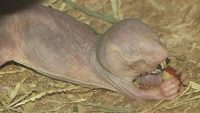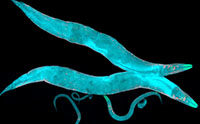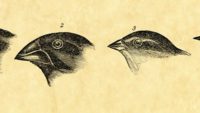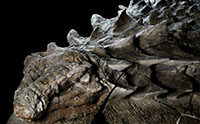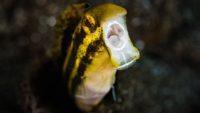By Dr. David Menton Seabirds have a special gland that helps them drink seawater. Amazingly, a few other birds can develop this salt gland, as needed. …read more Read more here: AIG Daily
“Yet evolutionists still want us to believe all this incredible complexity is just a product of mindless, random chance processes … yeah, right.” Admin Scientists studying the brain have discovered that the organ operates on up to 11 different dimensions, creating multiverse-like structures that are “a world we had never imagined.” By using an advanced mathematical system, researchers were able to uncover architectural structures that appears when the brain has to process information, before they disintegrate into nothing. Their findings, published in the journal Frontiers in Computational Neuroscience, reveals the hugely complicated processes involved in the creation of neural structures, [More]
What are the ramifications if scientists take the next step in creating artificial life? …read more Read more here: creation.com
Does the age of the universe matter? How does science confirm the Genesis record? Why can Christians confidently trust the biblical creation worldview? ICR Science Writer Brian Thomas uncovers convincing evidence in this series. From the tiniest cells to the largest stars, both science and the Bible provide evidence that leads to a logical conclusion of a recent creation. More… …read more Read more here: icr.org
By Laura Allnutt Brontosaurus, a diplodocid, is a family of dinosaurs with similar shape and form, so similar that the Brontosaurus has caused quite a bit of confusion. …read more Read more here: AIG Daily
Horses are horses, of course, and they had their genesis in Genesis. …read more Read more here: creation.com
By Karin Viet Animals fascinate humans. Whether playing with the family pet or gawking at the zoo wildlife, we marvel at the variety and complexity of these creatures. …read more Read more here: AIG Daily
By Ken Ham The Bible tells us that originally humans and animals were created vegetarian (Genesis 1:29, 30). Now, evolutionists have often mocked creationists by pointing to fossils with very sharp teeth and saying there’s no way such creatures were ever vegetarian. But many living creatures with sharp teeth eat only fruit or other vegetation. For example, the April issue of National Geographic featured a story about grass-eating monkeys of Ethiopia. These fearsome looking monkeys have massive incisors, yet they don’t use them for hunting or devouring meat. They are, in fact, the world’s only grass-eating monkeys. Could …read more [More]
By Simon Turpin Because of the impact of evolution on the theological world today, an increasing number of evangelical scholars are denying Adam’s historicity. …read more Read more here: AIG Daily
By Dr. Elizabeth Mitchell Naked mole-rats survive extreme oxygen deprivation in their crowded burrows by switching on fructose metabolizing machinery in their heart and brain cells. …read more Read more here: AIG Daily
Sneak peek of latest Creation magazine. From summer gold to winter blue-adjusting their eyes to the Arctic’s winter gloom is no problem for reindeer. …read more Read more here: creation.com
The February 2017 issue of Scientific American contains an article by three prominent theoretical physicists from Princeton and Harvard who strongly question the validity of cosmic inflation, an important part of the modern Big Bang theory. More… …read more Read more here: icr.org
How do we interpret the latest Homo naledi findings with their associated ‘ape-man’ connotations and claims? …read more Read more here: creation.com
The catastrophic event that revealed how wrongly geologists understood and explained volcanic landscapes. …read more Read more here: creation.com
Another spectacular dinosaur fossil discovery has baffled paleontologists who deny the historical accuracy of the book of Genesis. New Scientist recently reported the identification of a T. rex-like dinosaur from Upper Cretaceous system rocks in North Africa. What confounded the scientists were the phosphate-rich rocks in which the bones were found—rocks indicative of deposition in an open ocean. More… …read more Read more here: icr.org
By Mike Matthews Quick, can you tell the difference between an African and an Asian elephant? …read more Read more here: AIG Daily
Intriguing studies demonstrate that many different animals have the ability to transmit information about their environment to their offspring, sometimes using a process called epigenetics. Most often, the genetic memory of a parent or grandparent’s environmental experience traverses no farther than a half-dozen generations. Recently, researchers accidentally discovered the farthest-reaching epigenetic signal ever known. More… …read more Read more here: icr.org
By Ken Ham National Geographic recently ran an interesting story about the scablands in Washington State. The subtitle reads, “Geologists couldn’t account for the strange landforms of eastern Washington State. Then a high school teacher dared to question the scientific dogma of his day.” In 1909, high-school-teacher-turned-geologist J. Harlen Bretz noticed that the features of the scablands couldn’t be the result of slow and gradual processes over millions of years as was commonly believed at the time. He proposed that a massive flood carved out these startling features. But this “was geological heresy,” and his ideas were dismissed. And it [More]
By Avery Foley Evolutionists have long taught and believed that promiscuity increases genetic and rapid diversity, thereby helping the evolution of new species along. …read more Read more here: AIG Daily
By Avery Foley Have you ever stopped to consider how even chemistry showcases God’s handiwork, creativity, and care for his creation? …read more Read more here: AIG Daily
If evolution is true, why are many human behaviours anti-evolutionary? …read more Read more here: creation.com
The majority of dinosaur skeletons are cobbled together from fossil fragments. But a nodosaur recently put on display was so well preserved that it looks like a “statue.” It even contains tissue fragments. How could such a well-preserved dinosaur remain intact for millions of years? More… …read more Read more here: icr.org
In the Amazon River there is a creature with ‘electric’ senses it uses both in attack and defense. …read more Read more here: creation.com
By Ken Ham Road ecology is the study of “how roads, and the salts and chemicals we put on these roads, impact nearby nature.” Well, according to a new study, roads are leading to “rapid evolution” on either side of the highway. This isn’t the first time we’ve heard of so-called “rapid evolution”—scientists are increasingly observing small changes over short timescales and calling it “rapid evolution.” But is this change within various plant and animal kinds actually evolution in the sense that new genetic information is appearing? Rapid Evolution on Either Side of the Road? According to study coauthor Steven [More]
By Dr. Elizabeth Mitchell The tiny tropical fangblenny reveals fangs when it opens its mouth, but unusual venom is the real key to its defense—and to the defense of its look-alikes. …read more Read more here: AIG Daily
Evolutionary biology is experiencing its most serious division in over a century. Last November, Great Britain’s prestigious Royal Society held a conference to deliberate if evolutionary theory needed to be “extended” or even renovated to accommodate fresh ideas from new discoveries. How bad is this schism? More… …read more Read more here: icr.org
By Jeffrey P. Tomkins For many years, how many spawned the human race was not accessible. With modern genetics, scientists been able to more directly explore this question. …read more Read more here: AIG Daily




















![The Science Behind Recent Creation [Podcast] The Science Behind Recent Creation [Podcast]](http://proofthebibleistrue.com/wp-content/uploads/2017/06/77226-thumb-200x124.jpg)





